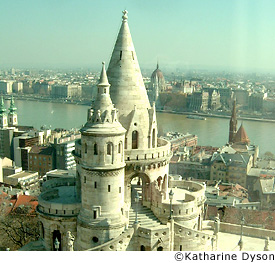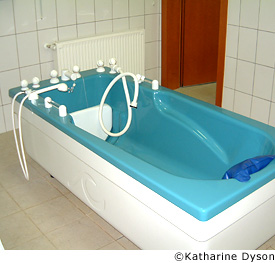Spa Treatments: East Meets West
Back-to-back massages, mud treatments and baths in Budapest
by Katharine Dyson Think "spa" and what comes to mind for Americans are soothing, pampering treatments like aromatherapy, facials and massages; soft new age music playing in the background; the trickle of fountains; soft lighting; and natural colors. But in Europe, where a spa stay is considered so important to your health that insurance often pays for it, spas are more treatment-oriented designed to relieve ailments like arthritis and psoriasis with a heavy emphasis on treatments through water (thalassotherapy).
Think "spa" and what comes to mind for Americans are soothing, pampering treatments like aromatherapy, facials and massages; soft new age music playing in the background; the trickle of fountains; soft lighting; and natural colors. But in Europe, where a spa stay is considered so important to your health that insurance often pays for it, spas are more treatment-oriented designed to relieve ailments like arthritis and psoriasis with a heavy emphasis on treatments through water (thalassotherapy).
In Budapest alone, where there are more than 100 thermal springs, some used for centuries, spas are integral to the Hungarian life style. Even in winter, when steam rises from outdoor pools as it hits the cold air, men play chess standing in the water up to their chests while snow drifts down around them. In Eastern Europe, people have long been serious about their spas coming here to ease their arthritis, musculoskeltal disorders, rheumatism, allergic problems, and for rehabilitation after surgery. Mineral springs, Kneipp and water therapy continue to play a key role in the menu of services and Europeans continue to believe strongly in their spas as necessary to their health and well-being.
But just as Eastern Europe is embracing democracy and fast food (94% of those 18 to 24 years of age in Budapest prefer fast food to traditional fare), so the spas are gradually adding features like music and enclosed softly lit rooms, not traditionally part of this region's evidence-based health centers.
Standing out for their extensive health and spa facilities are grand spa hotels like the Danubius Thermal Hotel Margitsziget and Danubius Grand Hotel Margitsziget, sister properties on Margaret Island, and the Danubius Thermal & Conference Hotel Helia on the Danube about 25 minutes out of town.
Checking into the Helio Hotel, a spa hotel in Budapest, I realized I hadn't packed sandals. Well, you need sandals. After all it was winter. But as guests typically put their robes on in their rooms and walk down the halls to the spa and pool areas where they spend the day, you need sandals. So I purchased pair of white vinyl slip-ons in the hotel shop for $10 (which I hope never to wear again).
Arriving at the spa check-in desk in my robe and shiny new white sandals, I was given a schedule of treatments to choose from. I had limited time so I signed up for everything I could fit into the next two days. I was told that a 20-minute massage was recommended. A mere 20 minutes? What were they thinking? I doubled up with back-to-back massages, mud treatments, baths--whatever was available.  Walking down the long white tiled halls of the spa lined by several treatment rooms, I realized it felt more like a hospital than a spa. Indeed before I could take any treatments, I had to be checked out by a doctor. He checked my blood pressure, my heart rate, medications, cheerfully asked about any existing conditions and sent me on my way with his approval. I was healthy enough, apparently... to have a massage.
Walking down the long white tiled halls of the spa lined by several treatment rooms, I realized it felt more like a hospital than a spa. Indeed before I could take any treatments, I had to be checked out by a doctor. He checked my blood pressure, my heart rate, medications, cheerfully asked about any existing conditions and sent me on my way with his approval. I was healthy enough, apparently... to have a massage.
The drill goes like this: once you have your schedule, you take it with you as you go from treatment to treatment. In between you hang out at the pool area (in your bathing suit), where you swim or soak in several interconnected pools with different temperatures of water--maybe grab a snack from the restaurant next to one of the pools or read in a chaise.
My first session was hot mud. Peering at my schedule for the day, the therapist said crisply in pretty good English, "You have too many things. You can't do them all. You'll be exhausted."
"How bad can massages and soaking in tubs be?" I answered, believing it as she slapped the mud on my back.
For the rest of the day, I plunged ahead, soaking in fancy tubs with jets, getting deep tissue massages, athletic massages and reflexology. I found the massage rooms a surprise. They were open about two feet from the ceiling, so rather than listening to Secret Garden or Yanni, I could hear staff members chatting and laughing as I was getting massaged. A bit disconcerting I thought.
And yes, at the end of the day, rather than feeling invigorated, I was bone tired. And one more day to go. The thing I was up for trying was their single-person infrared saunas which are not as hot as the traditional ones yet burn 20 percent fat in 25 minutes--try 800 calories in two minutes. My kind of weight loss. All you have to do is sit and sweat.
A growing trend is bringing people to Budapest for face lifts, vein surgery, dental work, tummy tucks, and other surgeries. This is especially hot in countries where insurance does not cover certain procedures and where the wait time is long for operations, the UK for example.
Mike Silford, director of the England-based Perfect Profiles, has been sending people from the UK to Budapest for two years for procedures like face lifts, collagen treatments, breast implants, vein sclerotizing, eye and dental work. Typical cost for a complete face lift is are about $2800 while the price is about $120 for a root canal and $280 for a crown. (http://www.perfectprofiles.eu.com)
Whereas Americans might be reluctant to use out-of-the country doctors, the Hungarian doctors are at the top of their field, very well trained. And itÕs interesting to note that the IntraLasik equipment used here, was actually tested in the Budapest for eight years and just came to the U.S. three years ago. Dr. Istvan Ferincz, managing director of the Focus Medical Eye Clinic at the Danuibus Thermal Hotel Margitsziget said that their requirements to do the laser and Lasik procedures are very strict. "Only about half those who want it are approved," he said. The Refractive Center performs everything from lasik (cost for one eye about $1000) to cataract surgery and clear lens extraction.
The 262-room Danubius Thermal & Conference Hotel Helia is about a half hour drive from the center of the city. Rooms are not huge nor are the bathrooms, still the clean Scandinavian style, balconies, panoramic windows revealing views of the Danube, use of large mirrors, granite vanities, light woodwork and good lighting show how good design can add up to very efficient and comfortable accommodations. The cozy lobby café and large dining room where an ample buffet is laid out for all meals along with the Health Spa and pool area attract those who want modern amenities along with an extensive health and wellness facility.
Closer to the city on Margaret Island, spa "junkies" will find a wide ranges of treatments, spas, pools, and things to do at the Danubius Thermal Hotel Margitsziget set in the middle of the Danube. A cushioned jogging track runs along the river and paths lead to the pretty parkland in the middle. Attached to the hotel is an extensive medical facility. Rooms are similar to those in the Thermal Hotel and the studio is particularly appealing with a large sitting area and separate toilet enclosure. The adjacent Danubius Grand Hotel Margitszet is connected by a wide enclosed tunnel to the health center and clinic. It has an elegant old world feeling with traditional furnishings and coffered ceilings.
For Americans who want a great deal on a health-related vacation, wish to experience new cultures, and come to a place where they will see mostly Europeans, a trip to Hungary or Romania can be a winner.
Tradesco Tours offers several spa plans in Hungary and Romania including a basic 7 night/8 day balneotherapy package at the Grand Hotel Margitsziget including five spa treatments, medical examination, use of pools, sauna, accommodations, and breakfasts and lunch or dinner daily. At the Thermal Hotel Margitszet a 21-day thermal spa special priced from $1,947 including airfare from New York gives you three weeks for the price of two with 15 treatments per week, medical examination, breakfast and lunch or dinner, transfers, use of fitness center and pools. One- and two-week programs are also available at other Budapest hotels. http://www.tradescotours.com / 800-448-4321
Spa Terms:
Aromatherapy: A massage with oils from plant and flower essences designed to relax skin's connective tissues.
Balneology: The study and practice of traditional water-based treatments.
Body Polish: Using large sea sponges to smooth, cleanse, exfoliate and hydrate the body.
Fango: A mud pack or body coating designed to promote the release of toxins and ease pain.
Herbal Wrap: Wrapping the body in hot linens, plastic sheets and blankets to enhance herbal essences and warmth applied to the skin.
Hydrotherapy: Underwater massage and other water-oriented treatments.
Mud Wrap: Using warm mud to cleanse pores and lift impurities.
Pilates: Movements designed to add strength and flexibility to the body.
Reiki: An ancient method using laying on of hands and mental and spiritual balancing to relieve acute emotional and physical conditions.
Reflexology: Massaging pressure points on feet, hands and ears to relieve tension and help heal internal organs.
Salt Glow: Coarse salt is used to cleanse skin.
Spinning: Using stationary bikes and various resistance levels in group sessions.
Swedish Massage: Using stroking, kneading, friction, tapping and vibration to relax muscles.
Thalassotherapy: Using seaweed, salt water, algae and sea air to improve well being.
Watsu: Underwater treatment blending deep tissue massage, acupressure, shiatsu and and yoga.
Vichy Shower: Lying on a cushioned waterproof mat and being showered by jets of water.
Zen Shiatsu: A Japanese acupressure art to relieve tension and balance the body.

